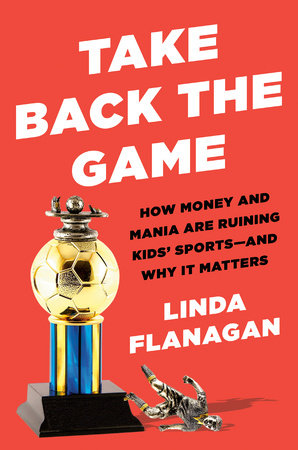How Money and Mania Have Transformed Youth Sports
by Laura Lambert
Youth sports have changed. I feel it every time I read a headline about a parent sucker-punching a referee or when one of my kids’ friends talks about driving three hours for a soccer tournament, yet again. In many corners of the US, sleepy local Little League games and low-stakes soccer games with pizza and ice cream afterward feel like dispatches from another era.
Today, youth sports is a $19 billion industry — not just a way to spend your Saturdays with your kids and community. Families (who can afford it) are retrofitting their lives around travel sports schedules and shelling out fees that can rival private school tuition.
And for what?
Kids today don’t play freely so much as they participate in the business of play. And that, says journalist Linda Flanagan, is the problem.
Flanagan explains how we got here in Take Back the Game: How Money and Mania Are Ruining Kids’ Sports — and Why It Matters.
First, money. Starting with the recession in the 70s, funding dried up for parks and rec centers, where free or affordable youth sports programs were born. When Title IX passed, demand for sports skyrocketed—and private industry got involved. Flanagan specifically points to the success of the Disney Wide World of Sports Complex, built in 1997. This early mecca of sports tourism proved recession-resistant and kick-started the demand for youth sports. Now there are about 30,000 multi-sport complexes across the US. Chances are, you know someone traveling to or from one right now.
Second, parenting changed. As journalist Jennifer Senior puts it in her book, All Joy and No Fun: The Paradox of Modern Parenthood, children went “from being our employees to our bosses.” And child-centric parenting, when coupled with the demands of high-stakes youth sports, means moms and dads spend an excessive amount of time and money schlepping to and from practices, games, private training, and tournaments—often for multiple children. “My parents wouldn’t have considered driving my siblings and me all over the place on the weekend. They had their own lives,” says Flanagan. “Now, it’s a sign of a good parent to spend $10,000 on travel lacrosse. It’s a public demonstration of that love.”
Third, college. The competition to get into and pay for college—and set your child up for success—has become cutthroat. And with colleges earmarking $3.6 billion yearly for athletic scholarships, the stakes feel higher than ever, even though only 1.8% of men and women play Division 1.
And these three forces have taken pickup basketball and neighborhood baseball and infused them with anxiety about class, status, money, and an unhealthy focus on achievement.
What happened to fun and games?
Flanagan shared her thoughts in a Q&A with Brightly:

Brightly: Whether you call it the professionalism of youth sports, or the commercialization of youth sports, the end result is the same—for many families, youth sports have become expensive and all-consuming, and it’s really not that fun anymore.
Flanagan: I’ve asked some of the people I talked to for the book who are immersed in it—they’re not happy, either. They’re kind of miserable. And when you ask, Have you ever thought about not doing it? Usually, their response is something like, “It feels like we have no choice. She loves it; we wouldn’t do it if she didn’t love it. It’ll get her into a better college.”
There’s also this long-standing belief in the power of youth sports, which is maybe one reason it’s so hard to understand how we got here. If youth sports are so good, why does it feel so bad?
It’s what Jay Coakley, who is the authority on all of this, calls the Great Sports Myth. This myth that sports are all good, they make you stronger and tougher, more resilient… All those wonderful warrior qualities.
I’ve really struggled writing this book, thinking about that myth.
I’ve personally learned a lot from sports. I think my kids have grown from their experience on teams. I don’t want to believe that it’s just something you do to pass the time. But what you learn from sports is entirely dependent on the context. It’s not by virtue of the sport.
Is there another, more accurate version of the Great Sports Myth that we can believe?
We know youth sports can be good for leadership, for community, for the physical benefits, for free play. If you allow kids to play amongst themselves without butting in and enforcing rules, they figure things out. That’s such an incredible learning experience, to figure out who’s on what team, to adjust the rules, to get along with different kids.
There is a New York Times story that stuck with me by a reporter who covered the mass shooting in Las Vegas. The reporter had just come back from Vegas and was at his daughter’s soccer game. One of the people who died in the shooting, their daughter was also playing in that game. It was such a beautiful story about the way the team embraced her and how the whole community rooted for her. To me, that’s how sports build community and why we want them.
It doesn’t have to be about a traumatic incident. Youth sports is about being amongst your neighbors, on the sidelines, connecting with people you might not know.
Of all the solutions you propose in your book—big and small, practical and radical—what do you think could have the most impact on kids and families?
I do believe one of the best places is focusing on energizing high school sports. Because that’s where kids are. Sports are already in public high schools. We can rethink how we do high school sports, to make greater use of space and fields and gyms and to try to create options for all kids, not just varsity teams.
This interview has been edited for length and clarity.

